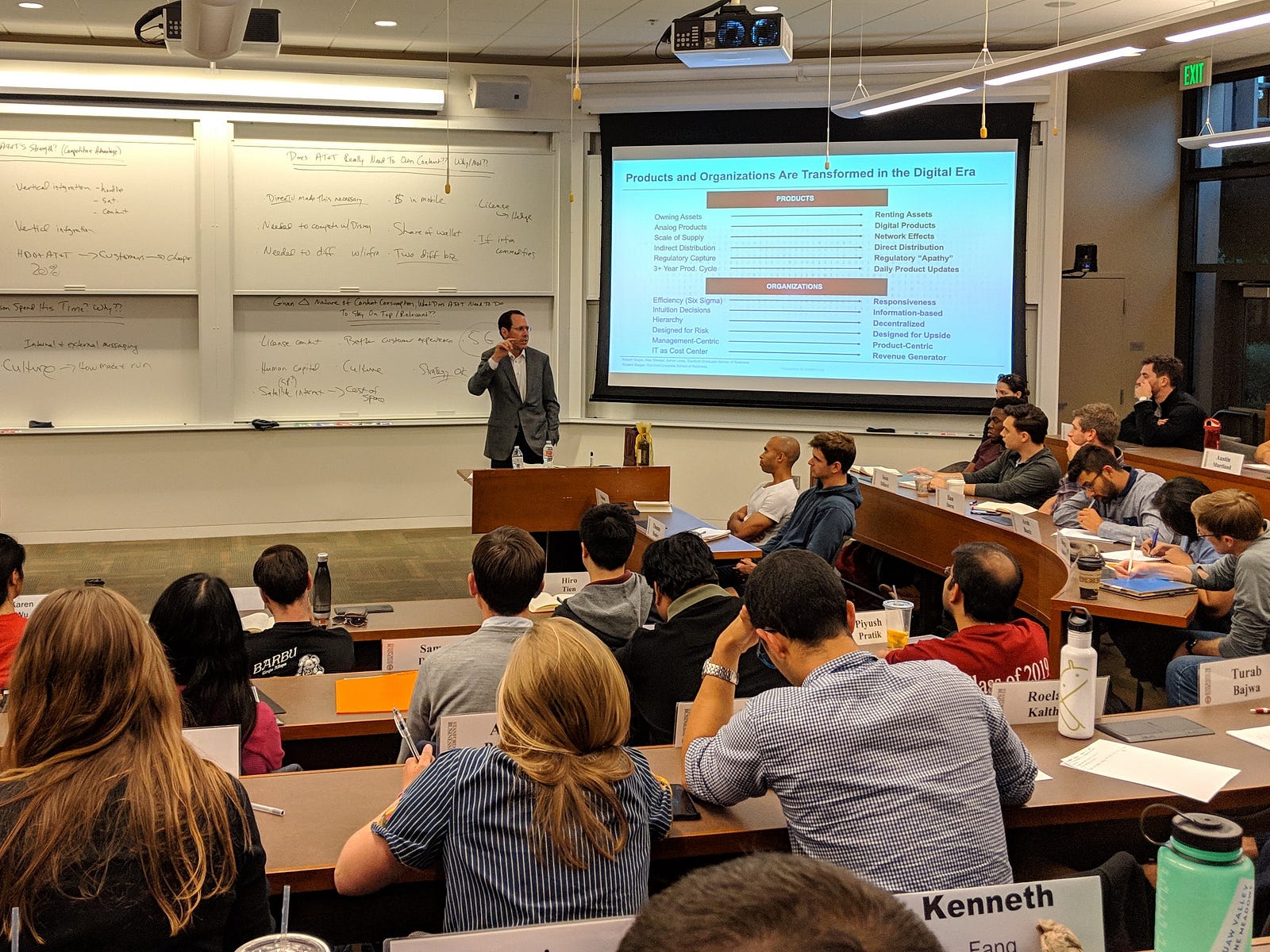This article was written by XSeed Partner Robert Siegel and appeared in the Industrialists Dilemma section of casasiegel.com.
I have to admit — I had this date highlighted on my calendar when AT&T Chairman and CEO Randall Stephenson committed to coming to our class this year. The size, scope and challenges of AT&T are as interesting as those facing any company that has come to visit Stanford since we began The Industrialist’s Dilemma four years ago. AT&T’s blend of growing an increasingly important digital infrastructure, running a complex physical operation to support this network, adding tremendous amounts of content and entertainment into the company (a very different business to running a communications infrastructure) all while navigating unprecedented regulatory challenges set the stage for an enlightening conversation.
And our discussion in class certainly did not disappoint my curiosity or my enthusiasm for this particular company’s dilemma.
 Going Big to Drive Change
Going Big to Drive Change
We spent a good portion of the session talking about AT&T’s acquisition of Time Warner — and whether or not it was necessary for the company to do. Stephenson discussed the company’s logic in making the decision to acquire Time Warner — as bandwidth capability continues to increase with the introduction of 5G, he and AT&T’s leadership believe that content will not diminish in its importance for customers. Consumers will look for new ways to be entertained, for new locations into which consume content, and for new products and devices with which to interact. In accepting this premise, leadership at AT&T believe that content will remain a growing differentiating vector on which to compete over the next several decades.
For the leadership of AT&T, the question they asked themselves was whether it was better to aggregate smaller content players over time (a strategy Stephenson referred to as putting together a “string of pearls”) or to look for the largest players with already rich content libraries that have the ability to deliver media that is already known to have high value to customers. The belief in the latter drove the logic of the $85 billion acquisition of Time Warner, and the transaction is now massively reshaping the business model of the company once known as Ma Bell. During the rise of the first internet boom, people argued that “content was king” and that telecommunication companies did not want to be simply “dumb pipes.” One could argue that content acquisition by communications firms over the previous two decades was an attempt to avoid commoditization of delivering solely a network that does not add much value. However, the current acquisition activities around content now seem to hinge on something new — the belief that combining content and infrastructure can deliver new and better customer experiences through the collection and analysis of data — which can only be done by combining both parts of the value stack.
AT&T — The Data Company
The teaching team fought about the wisdom of this strategy before class, and we even continued to argue about it amongst ourselves after Stephenson left. Stephenson discussed how by having better information on content viewing habits and behaviors, AT&T and the (since renamed) WarnerMedia properties would not only be able to deliver better content experiences, but that they would be able to deliver more targeted and customer-relevant advertising for the company’s media properties and existing advertising inventories. Stephenson posited that the ability to combine not only what content was being consumed, but also by having a deeper understanding of consumer behaviors for where and when the content was watched, will enable more effective and efficient advertising. The notion that “I know that 50% of my advertising is wasted money but I just don’t know which 50%” will give way, the thinking goes, to a deeper and richer capability that will combine both content preferences with location preferences, which will make for a more effective library of advertising slots to sell.
Whether or not someone accepts this premise, one of our “a-ha” moments as a teaching team was that no matter what AT&T’s business model was as a communications company in the past, they will now more resemble Google and Facebook in that they plan to deliver advertising models for premium video programming that perform as well as digital models. With digital advertising issues driving revenues, costs and actions around content and network development, the challenging regulatory issues already faced by this highly-regulated infrastructure provider is about to add the additional complexities of privacy and trust, and evolving TV advertising — both for consumers and marketers.
Oh, and don’t forget Amazon — perhaps the most feared and frequently mentioned company in our four years of teaching the course. With the growing success of Amazon Prime Video, with Amazon’s continued expansion into new markets, and with Amazon’s highly competent data and technology teams, AT&T now faces extremely capable and aggressive new competitors on its doorstep.
All While Managing Uniquely Distinct Cultures
Stephenson spent a fair amount of time talking about managing people and cultural issues inside of his 280,000+ person organization. While cultural transformation is a challenge for any company going through a radical change (AT&T has worked on retraining more than100,000 of its employees already), the company has the additional complexity of managing two very distinct cultures: the network and operational excellence of the historical AT&T with the creative and boundary-pushing ethos of WarnerMedia’s creative community.
When one also considers the global overlay of issues around geopolitical friction (e.g. China and the United States, Huawei, etc.), the personnel issues confronting Stephenson and the AT&T leadership team seem as complex and challenging as those facing any company that we have studied in the last four years.
Perhaps our biggest takeaway at the end of the session is our belief that these challenges and transformations will only continue to grow through the coming years. AT&T’s dilemma, while fascinating already, will be even more “entertaining” for the indefinite future.
